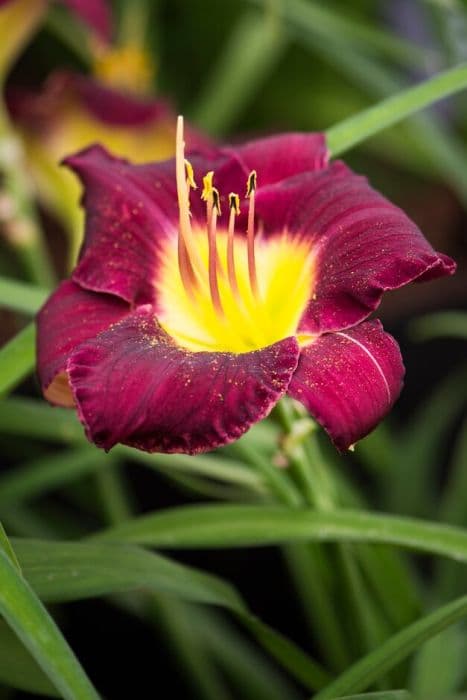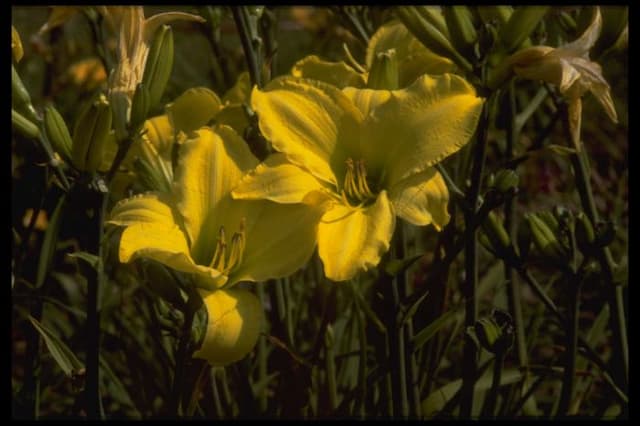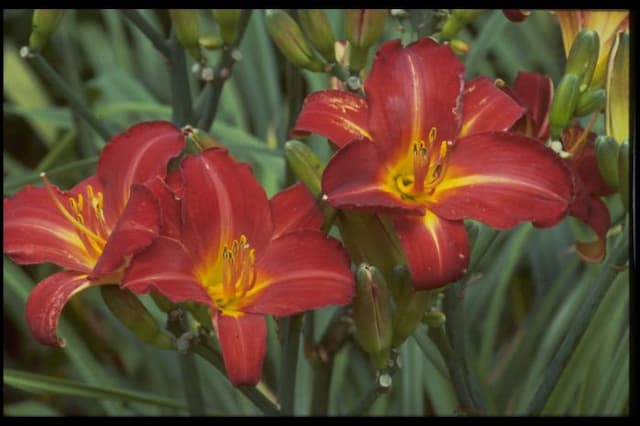Daylily Hemerocallis 'Hello Screamer'

ABOUT
The Hemerocallis 'Hello Screamer' is a captivating perennial commonly known as a Daylily. The distinct feature of 'Hello Screamer' is its vibrant, flamboyant flowers. Each bloom is a dazzling display of color, typically presenting bold shades such as deep reds, bright oranges, or striking yellows; the color may vary since daylilies come in a wide range of hues. The blossoms usually have a trumpet-like form, with softly ruffled edges that give the flowers a frilly, full appearance. The petals may exhibit eye-catching color contrasts, with a different shade or a throat marked by an alternate hue that can draw the eye and add depth to the overall presentation. In terms of foliage, 'Hello Screamer' produces a lush clump of strappy, green leaves. These leaves may arch gracefully and have a slightly leathery texture, offering a strong backdrop for the brilliance of the flowers. The plant has a robust, mounding habit, contributing to its lush appearance. The flowers themselves are perched atop sturdy, erect stalks that rise above the foliage, making the blooms prominent and visible. The Daylily is known for its resilience and low-maintenance qualities, often thriving under various conditions. Each individual flower typically blooms for just a day, as the name 'Daylily' suggests, hence they are constantly renewing their display with fresh blooms during their flowering season. The overall appearance of Hemerocallis 'Hello Screamer' is one of vibrancy and vitality, making it a show-stopper in any garden it graces.
About this plant
 Names
NamesFamily
Xanthorrhoeaceae
Synonyms
Daylily
Common names
Hemerocallis 'Hello Screamer'.
 Toxicity
ToxicityTo humans
The Hemerocallis 'Hello Screamer', commonly known as Daylily, is not generally considered toxic to humans. In fact, some species of Daylilies are cultivated for consumption, with their flowers and tubers being edible when prepared properly. However, it is essential to positively identify the plant and confirm its edibility, as misidentification could lead to consuming toxic plants. It is always recommended to proceed with caution and consult a reliable source before eating any part of a daylily or other plants from the wild. If a non-edible or misidentified plant is ingested, it could potentially lead to gastrointestinal discomfort or allergic reactions in some individuals. If you experience symptoms of poisoning, such as vomiting, diarrhea, or allergic reactions after consuming any part of a daylily, seek medical attention immediately.
To pets
The Hemerocallis 'Hello Screamer', commonly known as Daylily, is toxic to cats and potentially to some dogs. Ingesting even small amounts of any part of the plant can cause severe kidney damage in cats. Signs of daylily poisoning in pets, particularly cats, can include vomiting, lethargy, inappetence, and increased or decreased urination. If you suspect that your pet has ingested a daylily, it is crucial to seek veterinary care immediately. Early veterinary intervention is vital in preventing serious consequences, including potentially fatal kidney failure. In dogs, the toxicity varies, with some dogs reportedly showing signs of mild gastrointestinal upset after ingesting daylilies. Always keep daylilies out of reach of pets to ensure their safety.
 Characteristics
CharacteristicsLife cycle
Perennials
Foliage type
Deciduous
Color of leaves
Green
Flower color
Orange
Height
2 feet (0.61 meters)
Spread
2 feet (0.61 meters)
Plant type
Herb
Hardiness zones
3-9
Native area
Asia
Benefits
 General Benefits
General Benefits- Aesthetic Appeal: Adds vibrant color and visual interest to gardens with its striking flowers.
- Landscape Versatility: Suitable for a variety of landscaping themes, from formal to cottage gardens.
- Low Maintenance: Requires minimal care once established, making it ideal for gardeners of all skill levels.
- Drought Tolerance: Once established, it can withstand periods of low water, reducing the need for frequent irrigation.
- Rapid Growth: Grows quickly to fill in garden spaces and create a lush look.
- Pest Resistance: Generally resistant to pests, reducing the need for chemical treatments.
- Attracts Pollinators: Flowers attract bees, butterflies, and other beneficial insects, supporting local ecosystems.
- Edible Blooms: Flowers are edible and can be used to add a colorful garnish to dishes.
- Easy Propagation: Can be easily propagated from division, allowing gardeners to create more plants for free.
- Long Blooming Period: Offers a prolonged display of flowers, often blooming for several weeks.
- Adaptable to various soils: Thrives in a range of soil types, although it prefers well-drained conditions.
- Cold Hardy: Capable of withstanding colder climates, it remains hardy in many regions.
 Medical Properties
Medical PropertiesThis plant is not used for medical purposes.
 Air-purifying Qualities
Air-purifying QualitiesThis plant is not specifically known for air purifying qualities.
 Other Uses
Other Uses- The flowers of the daylily can be pressed and used in crafting, such as card making or decoupage, for their vibrant colors and interesting textures.
- Daylily blooms can be used as natural food dye, offering hues ranging from yellow to red depending on the part of the flower used and its concentration.
- The sturdy foliage of daylilies can be woven into small baskets or placemats when dried properly, exploiting their fibrous nature.
- Daylilies can be planted in outdoor pet areas as they are non-toxic to cats and dogs, making them a pet-friendly landscaping option.
- Dried daylily petals can be incorporated into homemade potpourris, contributing a subtle scent and a splash of color.
- The tuberous roots of daylilies can be used in water filtration systems for ponds, as they help to reduce algae by competing for nutrients.
- Daylilies can serve as a living mulch, suppressing weeds and helping to moderate soil temperature with their dense root system and foliage.
- The fibrous root system of the daylily is beneficial for erosion control on slopes or banks, as it helps to hold the soil in place.
- Daylily flowers can be frozen in ice cubes to create an attractive and edible garnish for summer drinks and cocktails.
- When planted in clusters, daylilies can serve as a natural privacy screen or a windbreak in gardens and landscapes.
Interesting Facts
 Feng Shui
Feng ShuiThe Daylily is not used in Feng Shui practice.
 Zodiac Sign Compitability
Zodiac Sign CompitabilityThe Daylily is not used in astrology practice.
 Plant Symbolism
Plant Symbolism- Daylily (Hemerocallis 'Hello Screamer'): Generally, the daylily symbolizes motherhood and nurturing due to its prolific nature and its role in Chinese culture. 'Hello Screamer', with its vibrant colors, might also suggest vitality and a sense of adventure.
- Transience: Because each bloom only lasts for a day, daylilies can symbolize the fleeting nature of life, encouraging us to cherish each moment.
- Renewal: As daylilies produce new flowers daily during their bloom season, they can represent renewal, hope, and new opportunities.
- Flirtation or Coquetry: In the language of flowers, a daylily sent to someone might imply a flirtatious or playful gesture due to its short-lived blooms.
 Water
WaterDaylilies need to be watered deeply and thoroughly, which means the soil should be soaked to a depth of about 8 inches to ensure the water reaches the root zone. The frequency of watering depends on climate conditions, but usually a deep watering once a week during dry periods is sufficient. Ensure that the soil has good drainage to prevent waterlogging. During the heat of the summer, you might need to water twice a week, especially if there's been no rain. Each watering session should be about 1 to 1.5 gallons of water, adjusting based on the size of the plant and the weather conditions.
 Light
LightDaylilies thrive in full sun to partial shade environments but bloom best with a minimum of six hours of direct sunlight per day. They are versatile, so if you are planting in a garden, choose a spot where they can receive ample morning sun and some afternoon shade. When grown in too much shade, daylilies will have fewer flowers and weaker stems.
 Temperature
TemperatureDaylilies are highly adaptable to a range of temperatures but grow best between 55°F and 75°F. They can survive minimum temperatures down to about -20°F once established. Daylilies prefer not to be exposed to extreme heat, as temperatures consistently above 90°F can stress the plants and affect blooming.
 Pruning
PruningPrune daylilies to remove dead foliage and spent flower stalks to encourage the plant to produce more blooms and to maintain a tidy appearance. Deadheading—the removal of faded flowers—can be done daily or every few days during the blooming period. The best time to prune back the foliage is in the fall or early spring, to prepare the plant for the growing season ahead.
 Cleaning
CleaningAs needed
 Soil
SoilDaylilies prefer well-draining soil with a slightly acidic to neutral pH, 6.0 to 7.0. A good soil mix for 'Hello Screamer' would be a combination of loamy garden soil, compost, and a small amount of sand or perlite to improve drainage.
 Repotting
RepottingDaylilies, including 'Hello Screamer', typically don't need frequent repotting and can thrive in the same spot for several years. Assess the need to repot or divide clumps every 3-5 years.
 Humidity & Misting
Humidity & MistingDaylilies are adaptable and do not require specific humidity levels, but they grow best in average outdoor humidity conditions.
 Suitable locations
Suitable locationsIndoor
It's tough to grow daylilies indoors; provide bright light.
Outdoor
Plant in sun to part-shade in well-draining soil.
Hardiness zone
3-9 USDA.
 Life cycle
Life cycleThe Hemerocallis 'Hello Screamer', commonly known as a variety of daylily, begins its life cycle as a seed, which, once germinated in soil with adequate moisture and temperature, will sprout and grow into a seedling. The seedling develops into a mature plant with strap-like foliage and establishes a robust root system, often forming a clump. As a perennial, the daylily enters a stage of yearly growth, where it emerges from dormancy in early spring, grows vigorously during the warm months, and blooms in the summer, producing vibrant flowers that typically last just one day. After blooming, the plant sets seed if the flowers have been pollinated, although many cultivated varieties like 'Hello Screamer' are often propagated through division rather than seed. In late summer or fall, the plant begins to enter a period of senescence, where foliage dies back, and it conserves energy in its roots for the winter. The cycle resumes with the return of favorable growing conditions in spring.
 Propogation
PropogationPropogation time
Late summer to fall
The Hemerocallis 'Hello Screamer', known commonly as the daylily, is usually propagated in late summer to early fall. The most popular method of propagation for daylilies is by division. This involves digging up the plant, washing or shaking off the soil to reveal the crown and roots, and using a sharp knife to cut apart the clumps into smaller sections. Each section should have at least two or three fans of leaves with corresponding roots. The divisions can then be replanted in the ground at the same depth they were growing before, spacing them about 18 to 24 inches (approximately 45 to 60 centimeters) apart to allow for growth. This allows the daylily to recover from the division before the onset of winter, with established roots ready to prompt new growth in spring.









